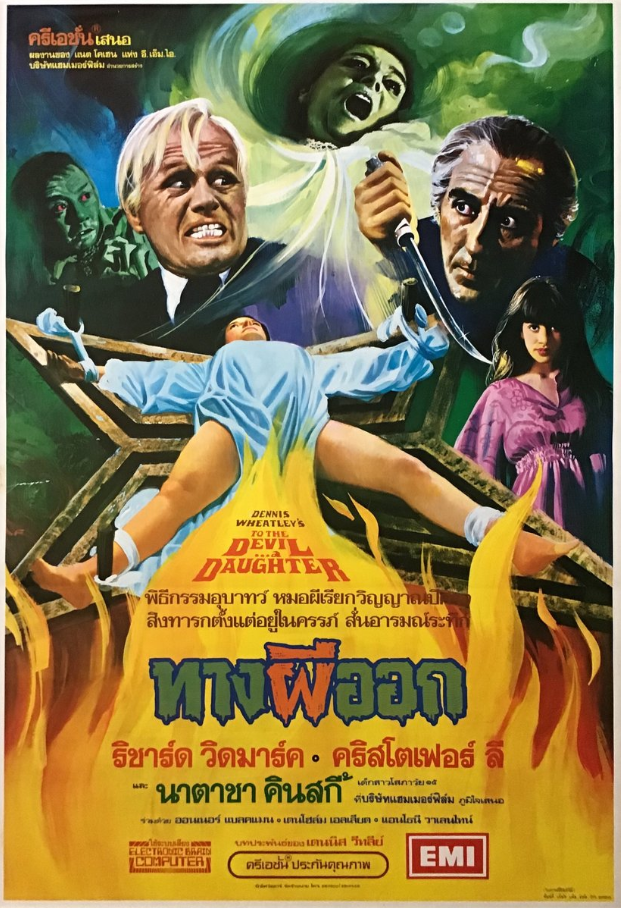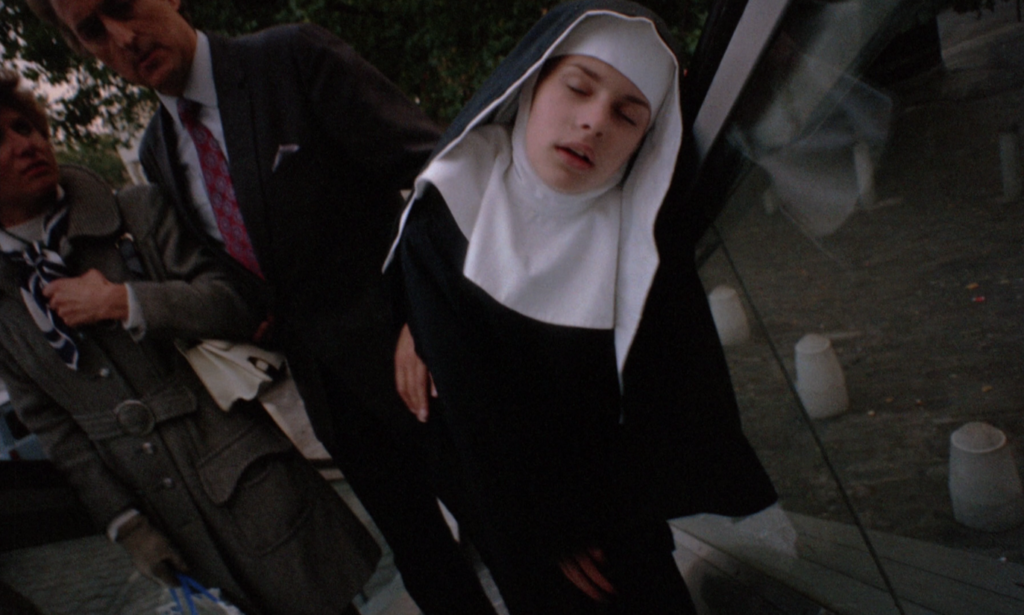
The swan song for Hammer horror (for a few decades, at least), To the Devil a Daughter (1976) is a belated attempt to present harder-edged genre material. Apart from perhaps the underrated psychological thriller Straight on Till Morning (1972), Daughter is the most downbeat and harrowing of Hammer’s many attempts that decade to tweak, update, or altogether abandon their old horror formulas. Let’s be clear: it’s a derivative and shameless movie that fits right in with the Satansploitation product of the era – what a delirious double feature with The Sentinel (1977) this would make. All of its flaws, artifacts of a troubled production, are inescapable, from a script that flirts with incoherence to a climax which is anything but climactic. And yet. And yet! The film has a somber atmosphere and soft-spoken sincerity that stand out more on a second viewing, as they did for this viewer’s. I cringed through the film the first time I saw it, which was quite a while ago. Revisiting the film on Blu-ray (it was released a couple years ago in the UK by StudioCanal, and last month by Scream Factory), having since read fan comments on the film ranging from tentatively positive to glowing, I find I can see past quivering, bloody, frog-eyed homunculus puppet to the ambitiously subversive Devil Rides Out (1968) follow-up it was always intended to be, and very nearly achieves.
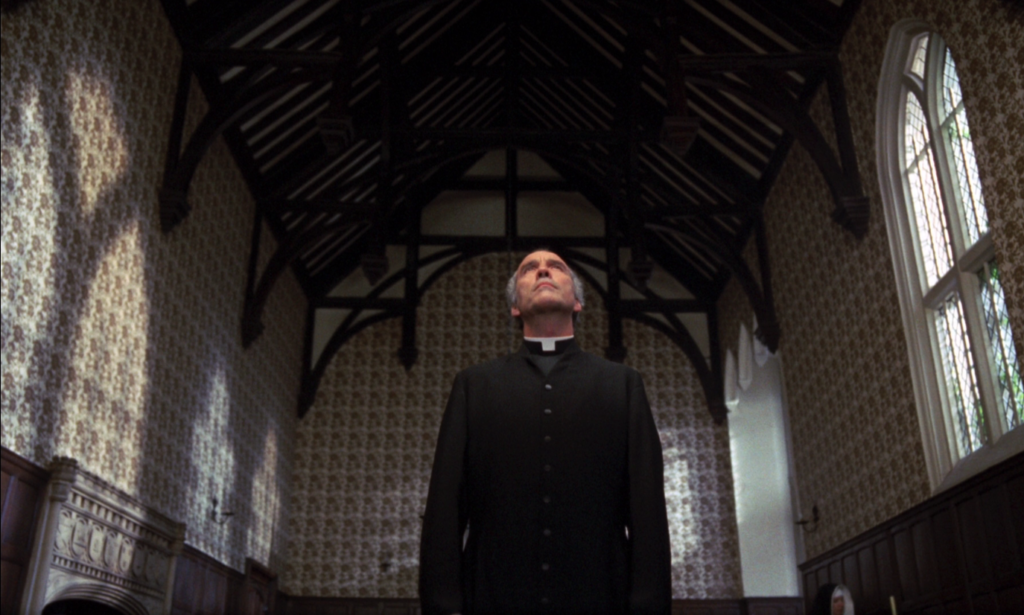
Christopher Lee as the evil Satanist Father Michael Rayner.
Though this isn’t a direct sequel to the classic The Devil Rides Out, it forms the third in an informal trilogy of Dennis Wheatley adaptations which that film initiated, quickly followed by 1968’s The Lost Continent (one of these is not like the others). In the 60’s Hammer had optioned a number of Wheatley’s popular novels including The Devil Rides Out, The Lost Continent, The Haunting of Toby Jugg, The Satanist, and To the Devil – a Daughter, but following their two initial releases, the next and last Wheatley wouldn’t start production until 1974, after James Carreras handed a crippled Hammer to his son Michael and as opportunities to get financing and distribution from the U.S. began to dry up. EMI stepped up to finance the majority of Daughter, requesting that Christopher Lee be attached in the role of the sinister Father Michael Rayner. Though Lee was an increasingly reluctant participant in Hammer horror in the impoverished 70’s – and would boast of the luxurious treatment he received on The Man with the Golden Gun (1974) – getting him to sign onto a Wheatley adaptation would not be a problem; he was friends with Wheatley and an enthusiastic participant in The Devil Rides Out, which in turn became one of his very best films. Yet Daughter would put him in the awkward position of watching the script revisions drift further and further away from the original novel, to the frustration of the author. Once the money finally arrived and filming could begin, the production had to contend with the chaos of a disruptive star, Richard Widmark, confusingly constant rewrites, and special effects that were either inadequate (the homunculus puppet) or absent (the climax). Regarding the latter, David Taylor explains in Little Shoppe of Horrors #39 (“The Road…to Hell! The Making of To the Devil…A Daughter,” October 2017) that originally Father Michael was going to be struck by lightning, but after the scene was shot with Lee, it was deemed too similar to the climax of Scars of Dracula (1970): “In the rush to get Lee’s scenes completed before his departure for Canada [to shoot The Keeper], there had been no provision for additional coverage that might have given [director Peter] Sykes and [producer Roy] Skeggs a little more leeway in the editing suite.” So Widmark throws a rock at Lee, who simply vanishes. Not since Lee was killed by a bush in The Satanic Rites of Dracula (1973)…
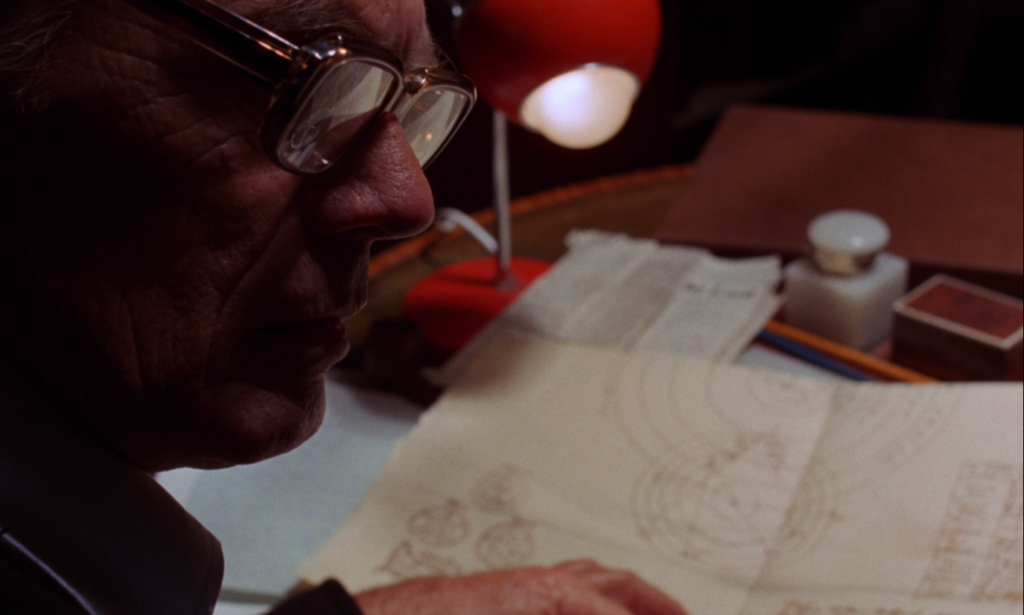
Richard Widmark as occult expert John Verney.
And yet. And yet! It may just be the phenomenon of lowered expectations, but once you realize that the climax of the film will be muted, you begin to tune into the eerily muted quality that Sykes (Demons of the Mind) lends the entire film. His film begins with intentionally disorienting cuts between disparate characters – Father Michael and his followers, occultist John Verney, a tormented middle-aged man named Henry Beddows (Denholm Elliott, Raiders of the Lost Ark), and Catherine, a teenage nun (Nastassja Kinski, daughter of Klaus and future star of Tess, Cat People, and Paris, Texas). We get a sense that Father Michael has been excommunicated, thanks to an elliptical prologue set two decades before the film’s events, but he is still surrounded by seemingly Catholic followers. We see Henry Beddows intrude upon Verney at a book reading, but we don’t hear what they’re talking about – the scene is shot from the point of view of Verney’s friends David (Anthony Valentine, Tower of Evil) and Anna (Honor Blackman, Goldfinger). Eventually Verney meets Catherine at the airport, says that he’s a friend of her father, and draws her quickly away from her escort in the manner of an abduction. Only then do we begin to connect the dots. Catherine has been under the influence of a sinister Satanic cult led by Father Michael, though Verney believes that most Satanists are charlatans in it for the sexual thrills; he rarely encounters “the other two percent,” though soon he’ll realize that’s exactly who he’s dealing with now. And Sykes reveals the true nature of Father Michael in a disturbing and protracted childbirth scene, the mother with her legs tied together, a willing participant in a painful ritual that results in a monstrous infant. As Sykes pans across the horrified faces of Michael’s followers, Lee suddenly lurches into the frame with a leering grin as unsettling as anything in his Draculas. He’s in full Wicker Man mode here.
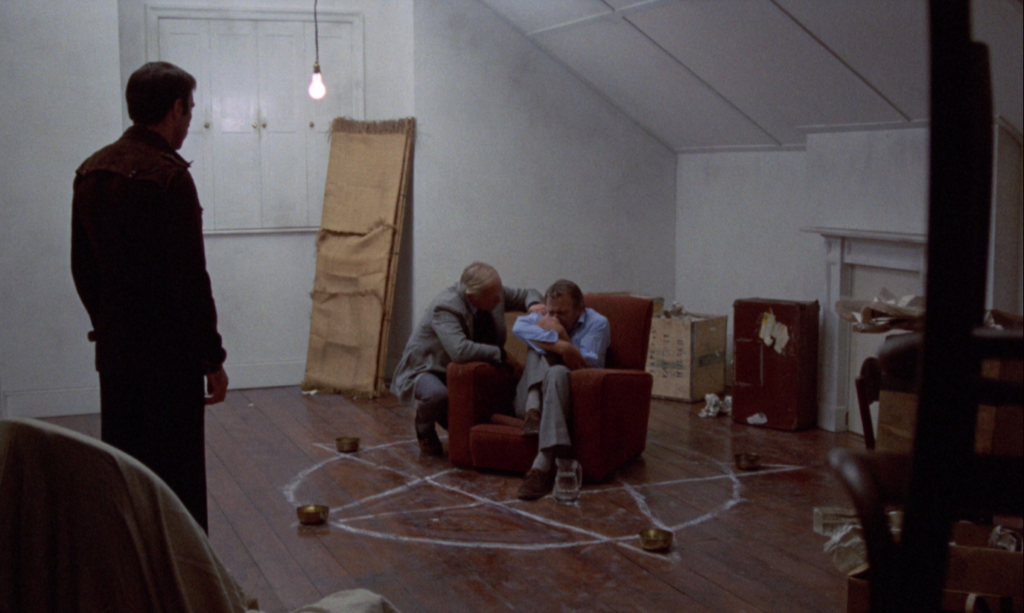
A gibbering Henry Beddows (Denholm Elliott) hides in his magic circle.
Throughout the film’s 92 minutes, Sykes builds suspense with only occasional bouts of sensationalism, which finally lurch into absurdity near the film’s ending, as Kinski lustfully paws the homunculus back into her womb – a dream sequence or hallucination or something that at least delivers on lowbrow outré. You see, Catherine was sold off by her parents at childbirth to become the avatar of the devil incarnation Astaroth. Confusingly, the frog-eyed fetus is apparently to fuse with her body to complete the transformation. Her distraught father, Beddows, has enlisted Verney to save her, but Father Michael uses black magic to threaten the increasingly rattled Beddows (in an effective scene where the phone Beddows is holding becomes a snake wrapped around his arm) and possesses Catherine to murder Anna and return to him to complete the ceremony. Generously, you could view To the Devil a Daughter as a darker answer to The Devil Rides Out. The protective circle of white magic, so famously utilized in the former film, here returns as a pathetic symbol of Beddows’ mental unraveling. Verney’s mounted defense also proves inadequate, as we watch his allies perish; even his final victory may not be one at all, as Sykes, doing the best he can through editing the footage he has, leaves the implication that Verney is too late and Catherine has become Astaroth. Though the film bears the scars of its production history, like many similar rocky productions, the end result is not a disaster. It’s an effectively unsettling little horror film, more original than most in its genre; it’s something that could have been a classic of 70’s horror with a more solid script and, it must be said, the recasting of Widmark, who lacks the charisma needed to pull this over the finish line. To the Devil a Daughter comes close to being a worthy capper to Hammer horror, despite the odds.
